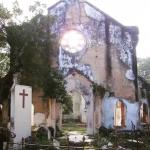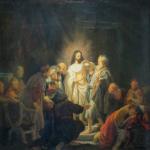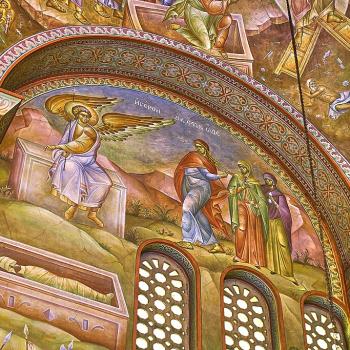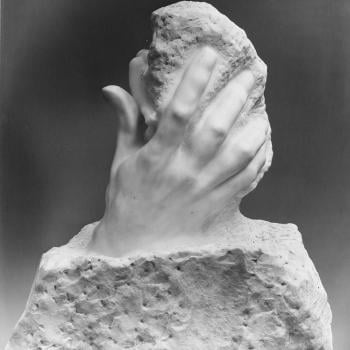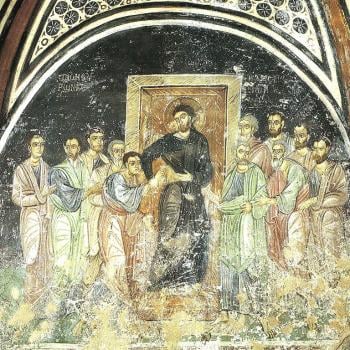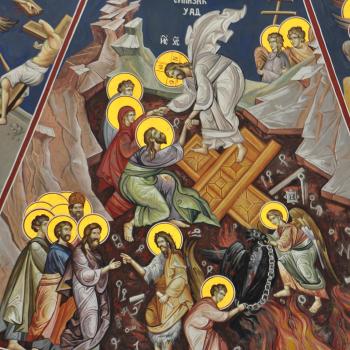
In 19th and early 20th century Russian philosophy, the writings of Nikolai Fedorov offered an interesting, albeit mistaken, idea concerning the resurrection of the dead: he thought God had given the task for humanity to establish the means by which the resurrection of the dead would be established. Jesus represented what was possible for the rest of us, and so we should likewise find the means, through science, to bring back all the dead. It would be a revivification or resuscitation, taking the best of what he thought positivism had to offer with the spiritual and moral implications of Christian theology:
The doctrine of resurrection could also be called positivism, but a positivism of action. According to this doctrine it would not be mythical knowledge that would be replaced by positive knowledge, but mythical, symbolic actions that would be replaced by actual, effective ones. The doctrine of resurrection sets no arbitrary limits to action performed in common, as opposed to action by separate individuals. This positivism of action derives not from mythology, which was a fabrication of pagan priests, but from mythological art forms, popular rituals and sacrifices. Resuscitation changes symbolic acts into reality. The positivism of action is not class-bound but popular positivism. For the people, science will be a method, whereas the positivism of science is merely a philosophy for scholars as a separate class or estate.[1]
Fedorov thought it was the duty of humanity to bring about the resuscitation of the dead because the living owed their very lives to their ancestors. In some of his comments, he did suggest, if humanity failed to follow their duty, God might have other ways of making sure there would be a resurrection of the dead. Nonetheless, he thought humanity should not be slothful and rely upon the supernatural authority of God; rather they should do what they can to achieve a universal restoration to life of all those who had once lived. He did not know how it would be possible, only that he thought it would be, and that science would offer the knowledge necessary to make it possible. He also understood the implications of such a resurrection of the dead. The earth could not realistically provide space for all those who had once been alive to live with everyone else. But as science could offer the means of their revivification, so science could be used to open up the whole universe to humanity so that they would have the space needed to thrive and not feel imprisoned in a tight space on earth. This is why his theories on space and space exploration, which came as a consequence to his ideas about reviving the dead, would serve as a launching point for the Russian space program, making his ideas have value beyond his Christian heritage. While Fedorov was wrong to think of the resurrection of the dead as some sort of resuscitation, the desire for the resuscitation and salvation of all humanity demonstrates a commendable Christian spirit, explaining how and why Christian philosophers, though disagreeing with his scientific theories, could and did take seriously the spirit of Fedorov’s unique philosophical ideas. His mistake is the kind which many make about the resurrection of the dead, which is why some have a difficultly understanding the difference between what happened to Lazarus and Jesus. Lazarus was resuscitated, he was brought back to mere temporal existence, allowing his life to continue before coming to a new temporal end: resurrection takes us beyond such temporality, beyond the constraints of space and time, as it brings us into a new mode of being, a new spiritualized materiality.
The resurrection of the dead is the transformation of earthly, temporal existence, to a new eternal form of existence, where all that one was in life, including their body, is brought together and made new. Resuscitation only brings back the spark of life to the body, not transforming the body into its eternal, glorified form. It is, to be sure, the same body, which is how and why many think resuscitation is the same thing as resurrection, but the body is spiritualized, it is made new, with characteristics and features which demonstrate its different mode of existence: it can take on a very physical form so that it can be touched, but it can also go beyond mere physicality as it does not find the constraints of time and space upon it in the way it did before the resurrection. This was what was demonstrated in many of the stories concerning the resurrected Christ in the Gospels: he was seen coming and going, appearing and disappearing, with no physical barriers like walks capable of impeding his movements. In our future resurrected form, that is in our own glorified bodies, we will be like Jesus, no longer having the temporal-spatial constraints as we have now with our temporal existence. Our existence will be transformed, so that instead of existing in a mere temporal form, we will have entered “eternal life” and will act according to the dictates of such “eternity.” We will no longer be “mere dust” but rather we will find the dust of our body has been spiritualized and become “heavenly”:
As was the man of dust, so are those who are of the dust; and as is the man of heaven, so are those who are of heaven. Just as we have borne the image of the man of dust, we shall also bear the image of the man of heaven. I tell you this, brethren: flesh and blood cannot inherit the kingdom of God, nor does the perishable inherit the imperishable (1Cor. 15:48-50 RSV).
Flesh and blood cannot inherit the kingdom of God: that is, those whose existence is merely physical, with the necessities of mere physical existence such as the need for nutrition, where life is sustained by the death of others. As the early Christian apologist Athenagoras explained, our body, our flesh will be transformed, so that it no longer suffers the necessities of food and drink (and likewise, breathing and other forms of deficiency will be overcome): ““Neither, again, will the bodies nourished then require the things they once required, seeing that, along with the want and corruption of the bodies nourished, the need also of those things by which they were nourished is taken away.”[2] The kingdom of death is overcome in the resurrection of the dead, and so that which relies upon the kingdom of the dead will be overturned; death will be no longer, and all that our body could lack which would lead it to death will be overcome.
But, it must be made clear, it is our body which is raised from the dead and transformed into a new state of being. St. John of Damascus, summarizing the Christian tradition, wrote:
Now, when we say resurrection of the dead, we mean a resurrection of bodies. For resurrection is a raising again of one who has fallen. But, since souls are immortal, how shall they rise again? Well if death is defined as a separation of soul from body, the resurrection is the perfect rejoining of soul and body, and the raising up again of the dissolved and fallen animal. Therefore, the very body which is corrupted and dissolved will itself rise up incorruptible. [3]
The fact that it is the same body, that it remains material in essence even if it is transformed into a new mode of being, is exactly what the Gospel writers indicate with the way Jesus meets with his followers in wake of his resurrection of the dead. He did not come to them as a mere ghost, but as a full-fledged human person with a body which can be touched: “See my hands and my feet, that it is I myself; handle me, and see; for a spirit has not flesh and bones as you see that I have” (Lk. 24:39 RSV). Jesus wanted his followers to know he was not some mere ghost, but rather, he truly was raised from the dead, with his own body and its flesh and bone.
In our resurrection, just like we find in Jesus, we will have the same body which we had in time, but it will be transformed: this is where Fedorov and many others misunderstand the meaning of the resurrection. It will be the same body, and so it will be flesh; we will not be mere fleshless spirits who are no longer “trapped” by the body. In this fashion, Fedorov was right in trying to understand the resurrection physically, overturning a Gnostic ideology which ignores the body and its eternal destiny, but he did not understand the transformation which was to take place as the glorified body transcends the limitations of time and space (which is why it can be said to be “spiritualized” while not a spirit). It is easy to understand this confusion, because, after all, we do not know or understand what it means to exist in eternity when we are focused upon and experience existence in a temporal form. It is difficult for us to truly comprehend the resurrection because it presents a new eschatological mode of existence. It is a glorified form of existence. Christ overcame the kingdom of death, the kingdom of sin; insofar as we continue to sin, insofar as we continue to be influenced and feel the impact of sin on our lives, insofar as we remain trapped within a temporal-spatial mode of being, all we can do is extrapolate in our thoughts what we think it will be like to experience resurrected glory. It is possible that some, through grace, can experience a foreshadow of eternity, to get a sense of what eternal existence is like, and through their experience help orient us to understand the life we shall have in the eschaton. But until we know eternity and experience eternal life itself, that is all we can have: a foreshadow of what is to come, with the representation of that glory in the resurrection of Jesus giving us a glimpse of what we will be like when we fully participate in the resurrection from the dead. It is not just resuscitation; it is not a return to mere temporal-spatial form of existence. Eternity is not mere infinite temporality. It is something else. Eternity transcends time even though it contains time within it. Eternal life, therefore, takes into it all that is found in time and lifts it up into a new mode of being: our body represents our temporal-spatial form of existence, with the glorified form of the body representing its assumption into heaven.
When we think of the resurrection of the dead, we find ourselves at an impasse. We know more of what it does not mean than what it means. We know it is the end of the kingdom of death, as Christ conquered death itself. We know it means that we will be an integrated whole, where our body and soul will be one, and as one, we will live and thrive in a way beyond our current comprehension. We will incorporate all that is within time within ourselves. Perhaps, that means, we will be able to interact with those in time, explaining how and why the saints are able to see, hear, and interact with those still in temporal existence. But we must not think this is all there will be. We will truly know existence as eternal life, where we truly are active in eternity itself. We will truly be set free. Fedorov’s theories, and those who think like him, would not allow us to experience eternity but rather by limited to temporal existence, even if it were infinite temporal existence. Science and its laws would be used to make sure we can continue to live and move and be and do what we want within the confines of a merely temporal form. The resurrection of Jesus, the glory of the resurrection, is that we are called to transcend such a mode of being. We are not just to return to life to have an infinite temporal existence: such an existence would likely turn out to be hellish. We are called to a new way of life, a boundless existence, a theosis where we partake not just material life, but the divine life itself, becoming true children of God. That is what we are called for. That is what we should learn from the resurrection of Jesus.
[1] Nikolai Fedorovich Fedorov, What Was Man Created For? The Philosophy of the Common Task. Trans. Elisabeth Koutaissoff and Marilyn Minto (London: Honeyglen Publishing Ltd, 1990), 56.
[2] St. Athenagoras, “The Resurrection of the Dead” in ANF (2):152.
[3] St. John of Damascus, “An Exact Exposition of the Orthodox Faith,” in Saint John of Damascus: Writings. trans. Frederic H. Chase, Jr. (New York: Fathers of the Church, 1958), 401.
Stay in touch! Like A Little Bit of Nothing on Facebook.
If you have liked what you read, please consider sharing it with your friends and family!


